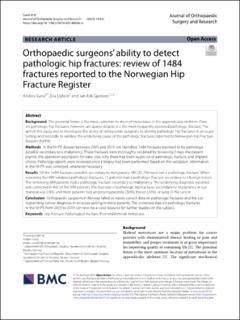| dc.contributor.author | Sund, Anders | |
| dc.contributor.author | Dybvik, Eva Hansen | |
| dc.contributor.author | Gjertsen, Jan-Erik | |
| dc.date.accessioned | 2024-04-12T13:00:18Z | |
| dc.date.available | 2024-04-12T13:00:18Z | |
| dc.date.created | 2023-11-20T21:42:03Z | |
| dc.date.issued | 2023-11-04 | |
| dc.identifier.issn | 1749-799X | |
| dc.identifier.uri | https://hdl.handle.net/11250/3126315 | |
| dc.description.abstract | Background: The proximal femur is the most common location of metastases in the appendicular skeleton. Data on pathologic hip fractures, however, are sparse despite it is the most frequently operated pathologic fracture. The aim of this study was to investigate the ability of orthopaedic surgeons to identify pathologic hip fractures in an acute setting and secondly to validate the underlying cause of the pathologic fractures reported to Norwegian Hip Fracture Register (NHFR).
Methods: In the NHFR dataset between 2005 and 2019, we identified 1484 fractures reported to be pathologic possibly secondary to a malignancy. These fractures were thoroughly validated by reviewing X-rays, the patient journal, the operation description for date, side, why there had been suspicion of pathologic fracture, and implant choice. Pathology reports were reviewed once a biopsy had been performed. Based on this validation, information in the NHFR was corrected, whenever necessary.
Results: Of the 1484 fractures possible secondary to malignancy, 485 (32.7%) were not a pathologic fracture. When reviewing the 999 validated pathologic fractures, 15 patients had a pathologic fracture secondary to a benign lesion. The remaining 984 patients had a pathologic fracture secondary to malignancy. The underlying diagnosis reported was corrected in 442 of the 999 patients. The true rate of pathologic hip fractures secondary to malignancy in our material was 0.8%, and most patients had underlying prostate (30%), breast (20%), or lung (17%) cancer.
Conclusion: Orthopaedic surgeons in Norway failed to report correct data on pathologic fractures and the corresponding cancer diagnosis in an acute setting in many patients. The corrected data on pathologic fractures in the NHFR from 2005 to 2019 can now be a valid resource for further studies on the subject. | en_US |
| dc.language.iso | eng | en_US |
| dc.publisher | BMC | en_US |
| dc.rights | Navngivelse 4.0 Internasjonal | * |
| dc.rights.uri | http://creativecommons.org/licenses/by/4.0/deed.no | * |
| dc.title | Orthopaedic surgeons' ability to detect pathologic hip fractures: review of 1484 fractures reported to the Norwegian Hip Fracture Register | en_US |
| dc.type | Journal article | en_US |
| dc.type | Peer reviewed | en_US |
| dc.description.version | publishedVersion | en_US |
| dc.rights.holder | Copyright 2023 the authors | en_US |
| dc.source.articlenumber | 832 | en_US |
| cristin.ispublished | true | |
| cristin.fulltext | original | |
| cristin.qualitycode | 1 | |
| dc.identifier.doi | 10.1186/s13018-023-04336-w | |
| dc.identifier.cristin | 2199148 | |
| dc.source.journal | Journal of Orthopaedic Surgery and Research | en_US |
| dc.identifier.citation | Journal of Orthopaedic Surgery and Research. 2023, 18, 832. | en_US |
| dc.source.volume | 18 | en_US |

